Comprehensive Analysis of Toyota's Operations Management Strategies
VerifiedAdded on 2020/01/23
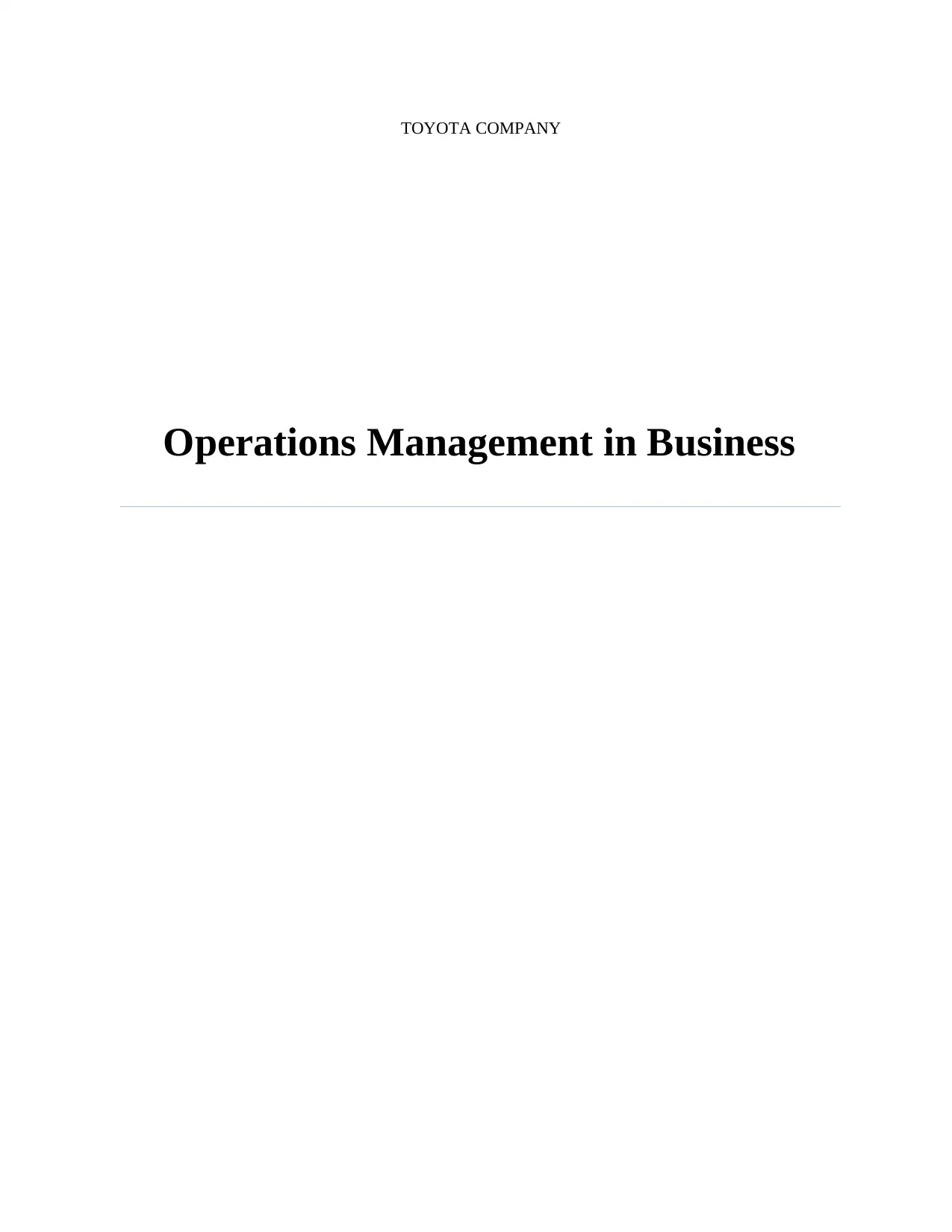
Operations Management in Business
Paraphrase This Document

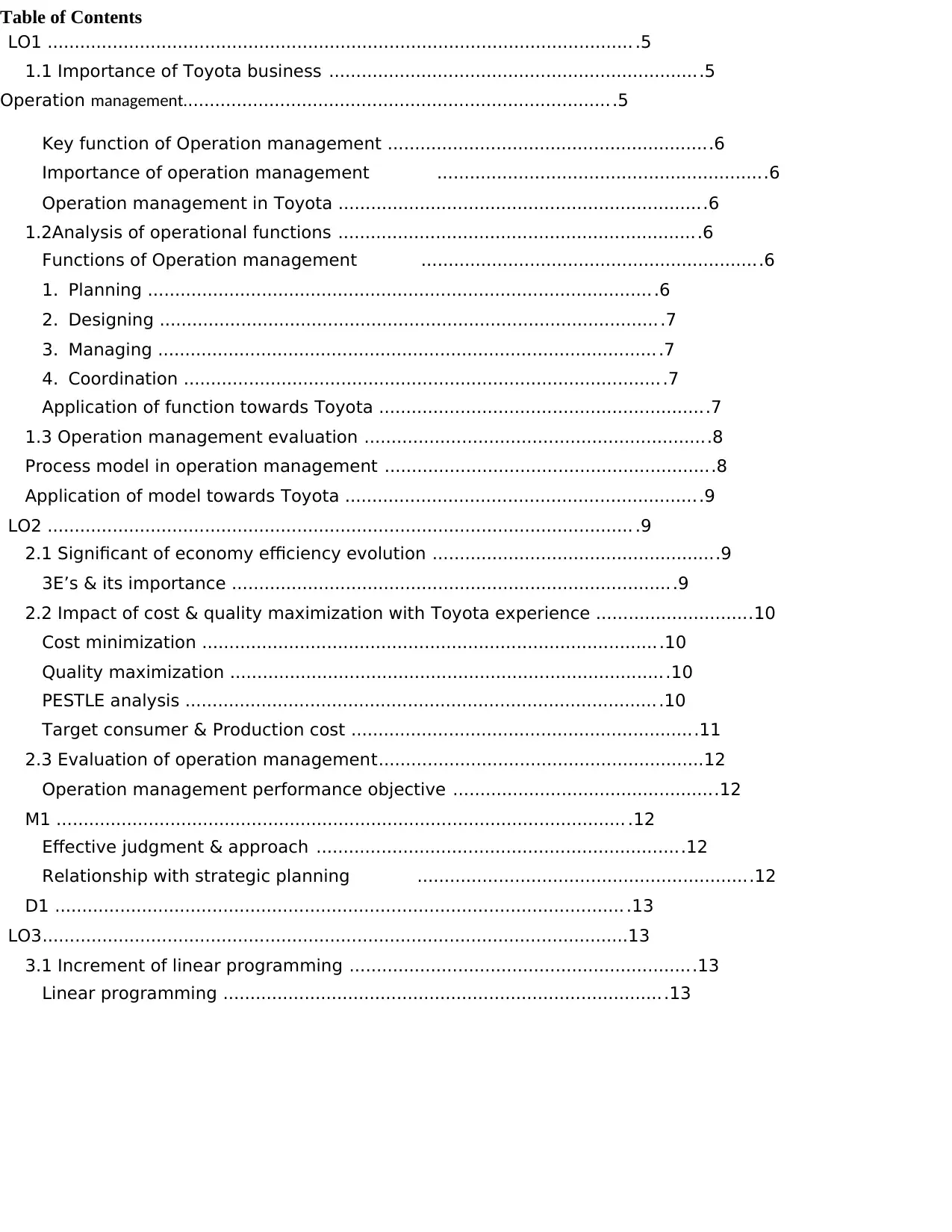
LO1 ............................................................................................................ .5
1.1 Importance of Toyota business .....................................................................5
Operation management................................................................................5
Key function of Operation management ............................................................6
Importance of operation management .............................................................6
Operation management in Toyota ....................................................................6
1.2Analysis of operational functions ...................................................................6
Functions of Operation management ...............................................................6
1. Planning ............................................................................................. .6
2. Designing ............................................................................................ .7
3. Managing ............................................................................................ .7
4. Coordination ........................................................................................ .7
Application of function towards Toyota .............................................................7
1.3 Operation management evaluation ................................................................8
Process model in operation management .............................................................8
Application of model towards Toyota ..................................................................9
LO2 ............................................................................................................ .9
2.1 Significant of economy efficiency evolution .....................................................9
3E’s & its importance ..................................................................................9
2.2 Impact of cost & quality maximization with Toyota experience .............................10
Cost minimization .....................................................................................10
Quality maximization .................................................................................10
PESTLE analysis ....................................................................................... .10
Target consumer & Production cost ................................................................11
2.3 Evaluation of operation management............................................................12
Operation management performance objective .................................................12
M1 ......................................................................................................... .12
Effective judgment & approach ....................................................................12
Relationship with strategic planning ..............................................................12
D1 ......................................................................................................... .13
LO3............................................................................................................13
3.1 Increment of linear programming ................................................................13
Linear programming ..................................................................................13
⊘ This is a preview!⊘
Do you want full access?
Subscribe today to unlock all pages.

Trusted by 1+ million students worldwide
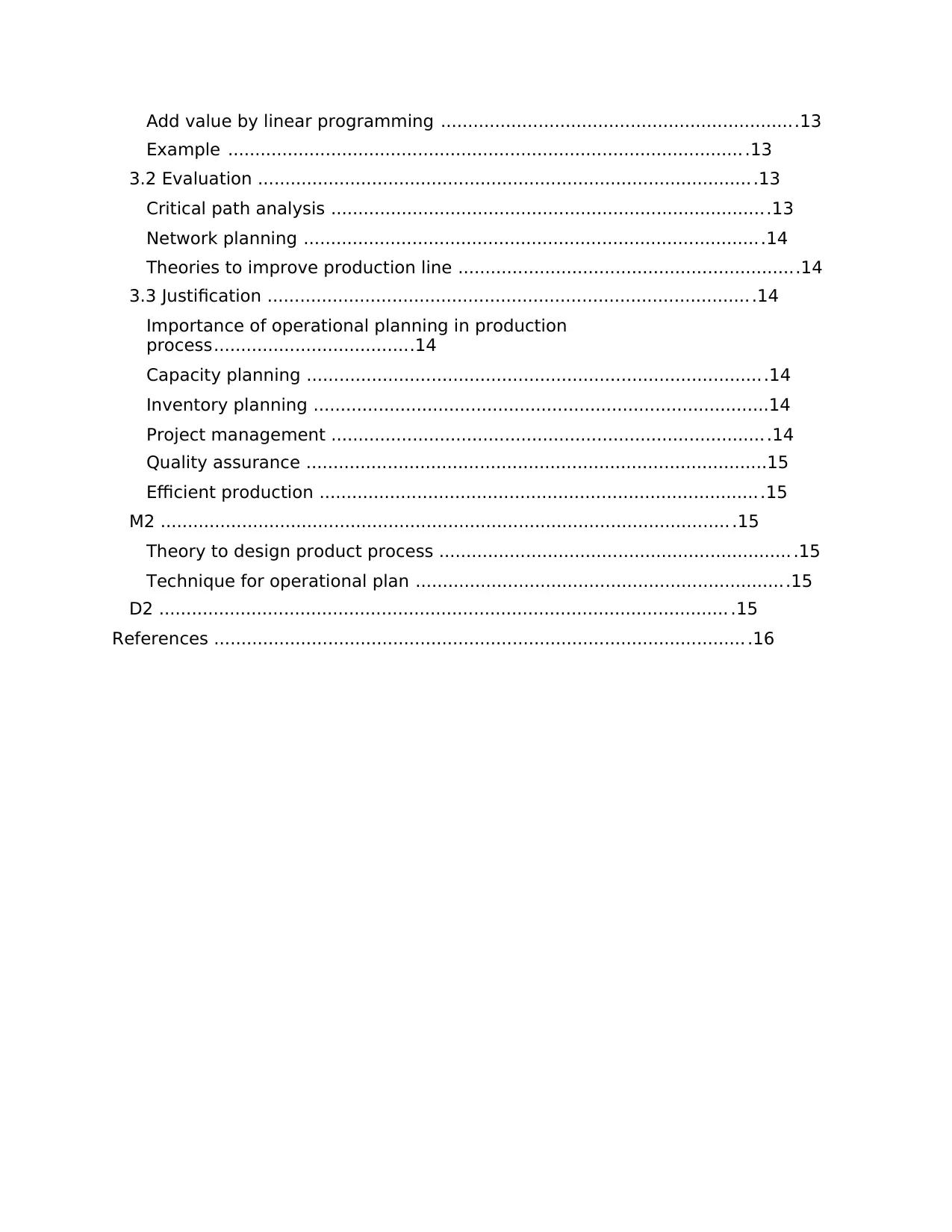
Example ............................................................................................... .13
3.2 Evaluation ........................................................................................... .13
Critical path analysis .................................................................................13
Network planning .....................................................................................14
Theories to improve production line ...............................................................14
3.3 Justification ......................................................................................... .14
Importance of operational planning in production
process.....................................14
Capacity planning .....................................................................................14
Inventory planning ....................................................................................14
Project management ................................................................................ .14
Quality assurance .....................................................................................15
Efficient production ..................................................................................15
M2 ......................................................................................................... .15
Theory to design product process ................................................................. .15
Technique for operational plan .....................................................................15
D2 ......................................................................................................... .15
References .................................................................................................. .16
Paraphrase This Document
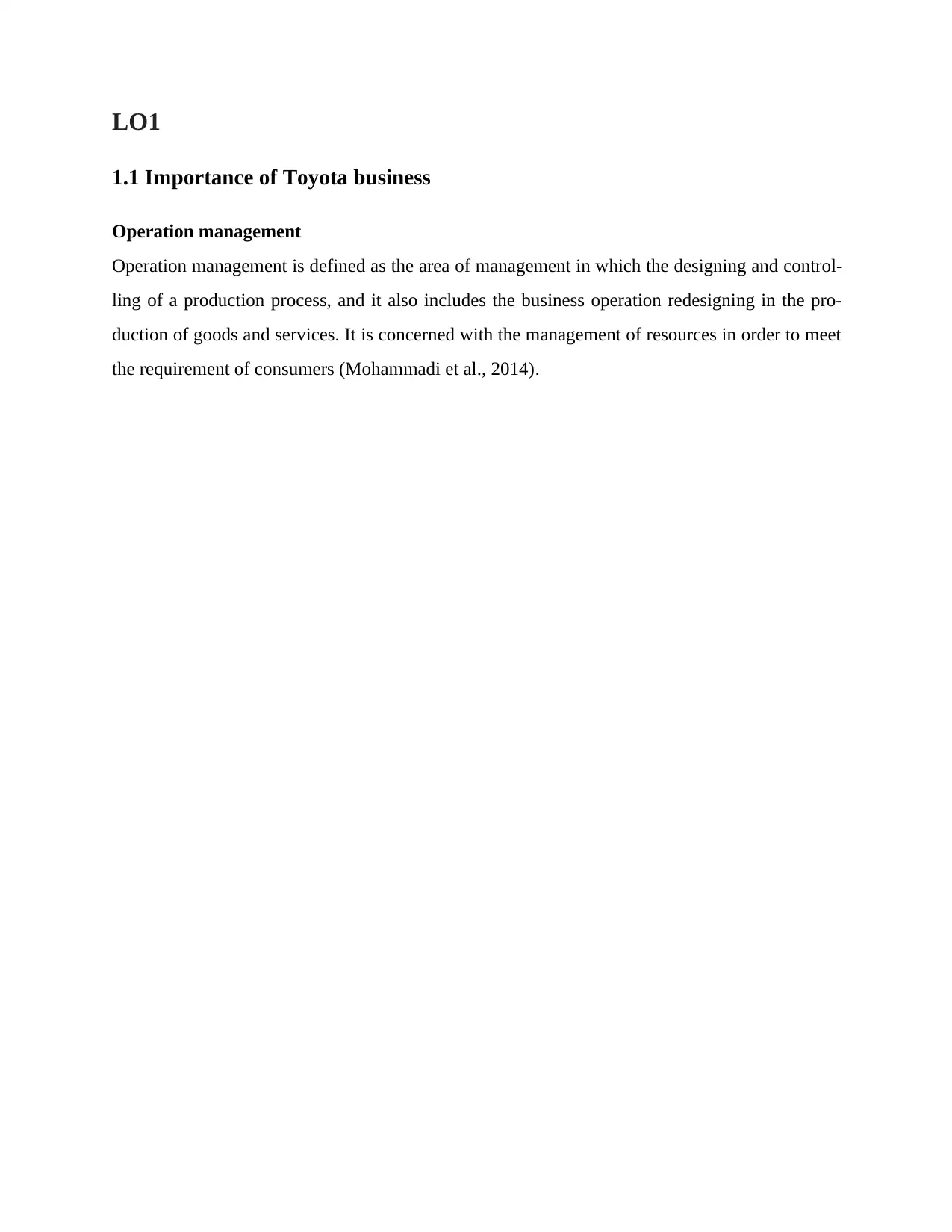
1.1 Importance of Toyota business
Operation management
Operation management is defined as the area of management in which the designing and control-
ling of a production process, and it also includes the business operation redesigning in the pro-
duction of goods and services. It is concerned with the management of resources in order to meet
the requirement of consumers (Mohammadi et al., 2014).
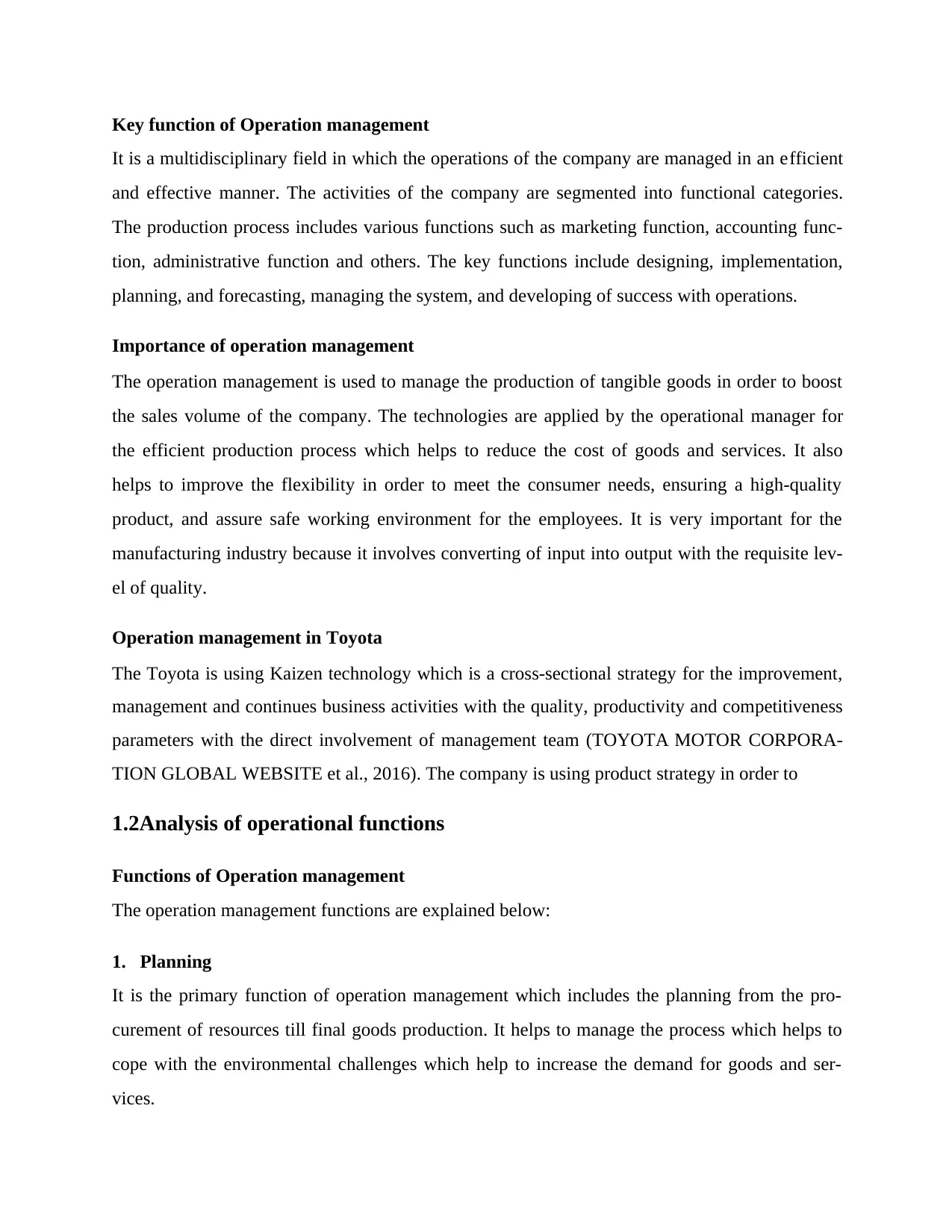
It is a multidisciplinary field in which the operations of the company are managed in an efficient
and effective manner. The activities of the company are segmented into functional categories.
The production process includes various functions such as marketing function, accounting func-
tion, administrative function and others. The key functions include designing, implementation,
planning, and forecasting, managing the system, and developing of success with operations.
Importance of operation management
The operation management is used to manage the production of tangible goods in order to boost
the sales volume of the company. The technologies are applied by the operational manager for
the efficient production process which helps to reduce the cost of goods and services. It also
helps to improve the flexibility in order to meet the consumer needs, ensuring a high-quality
product, and assure safe working environment for the employees. It is very important for the
manufacturing industry because it involves converting of input into output with the requisite lev-
el of quality.
Operation management in Toyota
The Toyota is using Kaizen technology which is a cross-sectional strategy for the improvement,
management and continues business activities with the quality, productivity and competitiveness
parameters with the direct involvement of management team (TOYOTA MOTOR CORPORA-
TION GLOBAL WEBSITE et al., 2016). The company is using product strategy in order to
1.2Analysis of operational functions
Functions of Operation management
The operation management functions are explained below:
1. Planning
It is the primary function of operation management which includes the planning from the pro-
curement of resources till final goods production. It helps to manage the process which helps to
cope with the environmental challenges which help to increase the demand for goods and ser-
vices.
⊘ This is a preview!⊘
Do you want full access?
Subscribe today to unlock all pages.

Trusted by 1+ million students worldwide
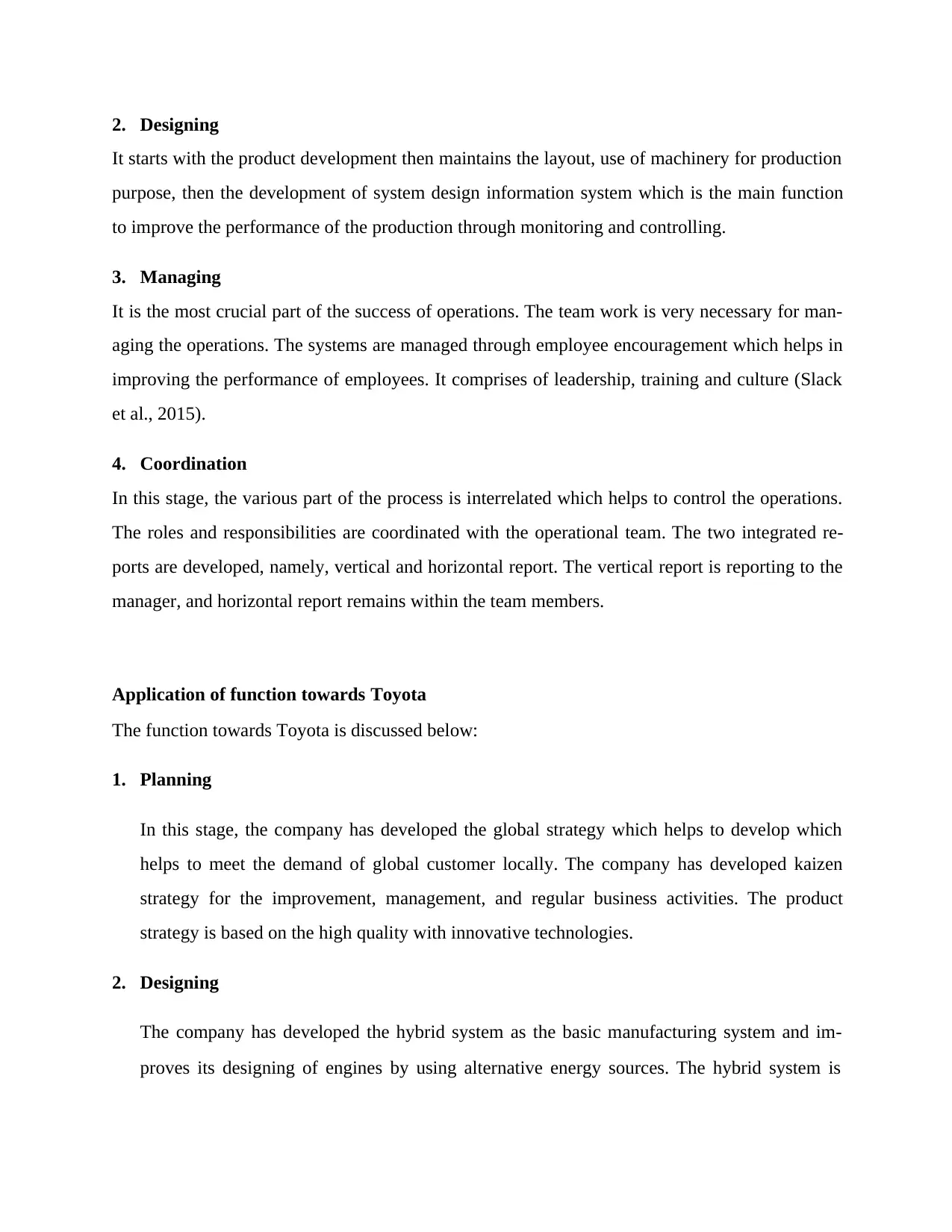
It starts with the product development then maintains the layout, use of machinery for production
purpose, then the development of system design information system which is the main function
to improve the performance of the production through monitoring and controlling.
3. Managing
It is the most crucial part of the success of operations. The team work is very necessary for man-
aging the operations. The systems are managed through employee encouragement which helps in
improving the performance of employees. It comprises of leadership, training and culture (Slack
et al., 2015).
4. Coordination
In this stage, the various part of the process is interrelated which helps to control the operations.
The roles and responsibilities are coordinated with the operational team. The two integrated re-
ports are developed, namely, vertical and horizontal report. The vertical report is reporting to the
manager, and horizontal report remains within the team members.
Application of function towards Toyota
The function towards Toyota is discussed below:
1. Planning
In this stage, the company has developed the global strategy which helps to develop which
helps to meet the demand of global customer locally. The company has developed kaizen
strategy for the improvement, management, and regular business activities. The product
strategy is based on the high quality with innovative technologies.
2. Designing
The company has developed the hybrid system as the basic manufacturing system and im-
proves its designing of engines by using alternative energy sources. The hybrid system is
Paraphrase This Document
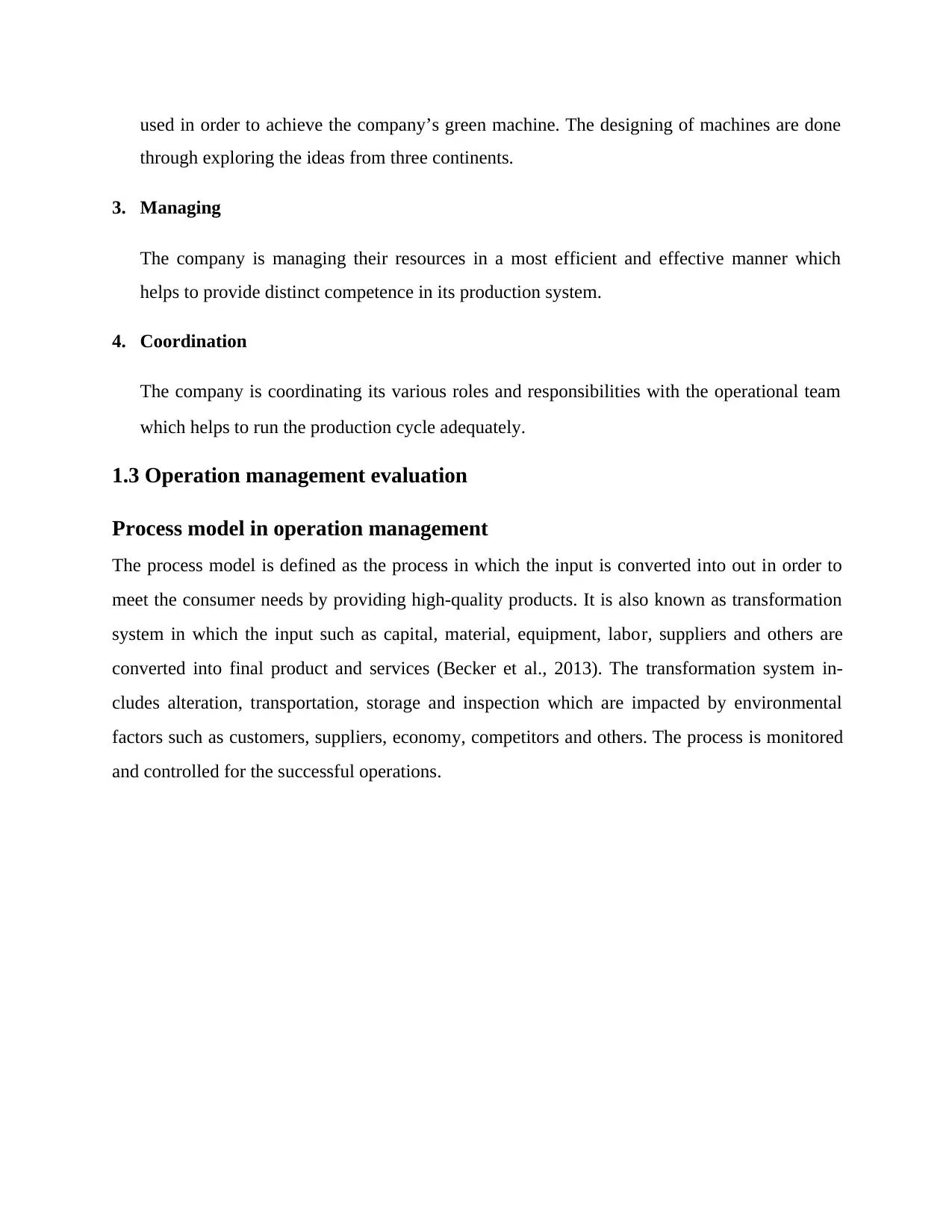
through exploring the ideas from three continents.
3. Managing
The company is managing their resources in a most efficient and effective manner which
helps to provide distinct competence in its production system.
4. Coordination
The company is coordinating its various roles and responsibilities with the operational team
which helps to run the production cycle adequately.
1.3 Operation management evaluation
Process model in operation management
The process model is defined as the process in which the input is converted into out in order to
meet the consumer needs by providing high-quality products. It is also known as transformation
system in which the input such as capital, material, equipment, labor, suppliers and others are
converted into final product and services (Becker et al., 2013). The transformation system in-
cludes alteration, transportation, storage and inspection which are impacted by environmental
factors such as customers, suppliers, economy, competitors and others. The process is monitored
and controlled for the successful operations.
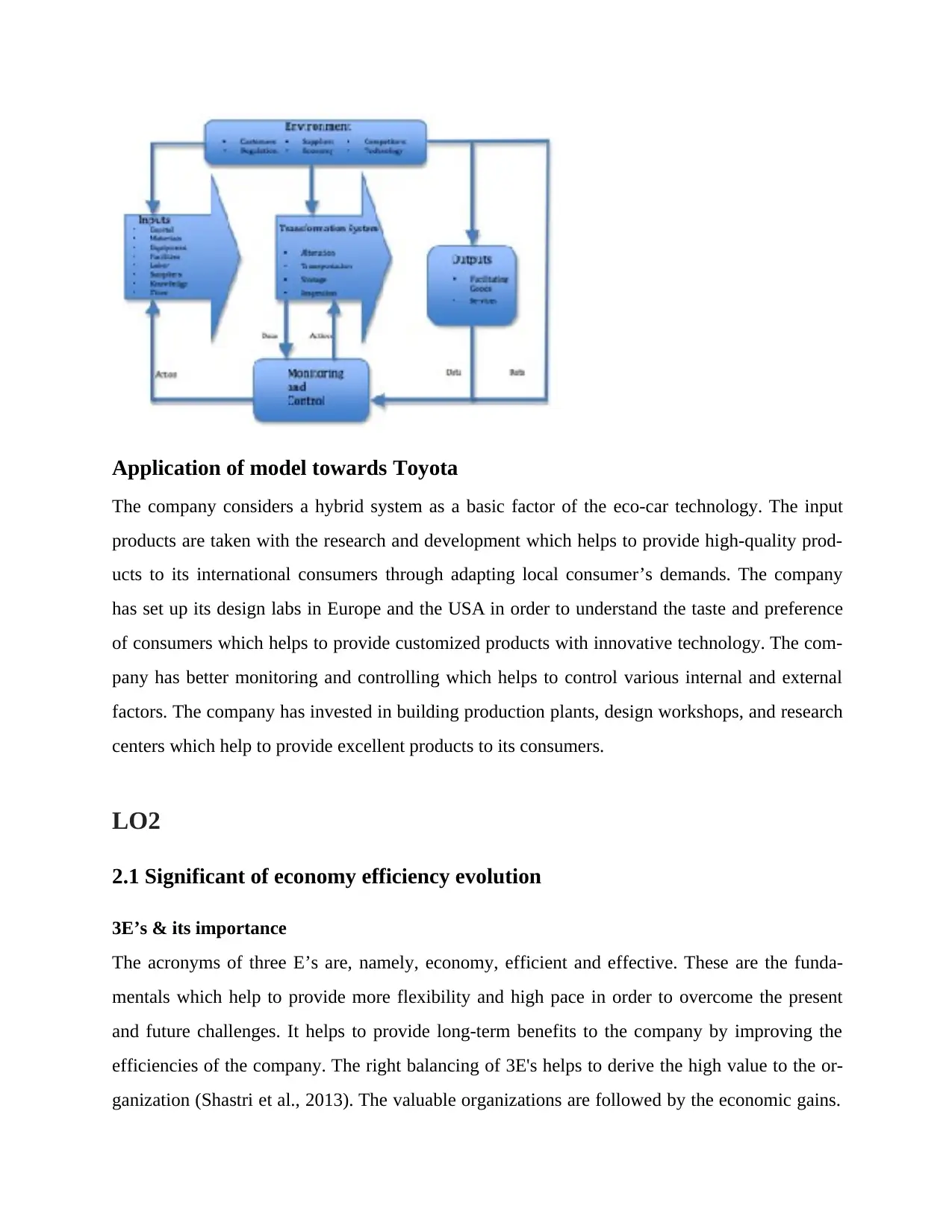
The company considers a hybrid system as a basic factor of the eco-car technology. The input
products are taken with the research and development which helps to provide high-quality prod-
ucts to its international consumers through adapting local consumer’s demands. The company
has set up its design labs in Europe and the USA in order to understand the taste and preference
of consumers which helps to provide customized products with innovative technology. The com-
pany has better monitoring and controlling which helps to control various internal and external
factors. The company has invested in building production plants, design workshops, and research
centers which help to provide excellent products to its consumers.
LO2
2.1 Significant of economy efficiency evolution
3E’s & its importance
The acronyms of three E’s are, namely, economy, efficient and effective. These are the funda-
mentals which help to provide more flexibility and high pace in order to overcome the present
and future challenges. It helps to provide long-term benefits to the company by improving the
efficiencies of the company. The right balancing of 3E's helps to derive the high value to the or-
ganization (Shastri et al., 2013). The valuable organizations are followed by the economic gains.
⊘ This is a preview!⊘
Do you want full access?
Subscribe today to unlock all pages.

Trusted by 1+ million students worldwide
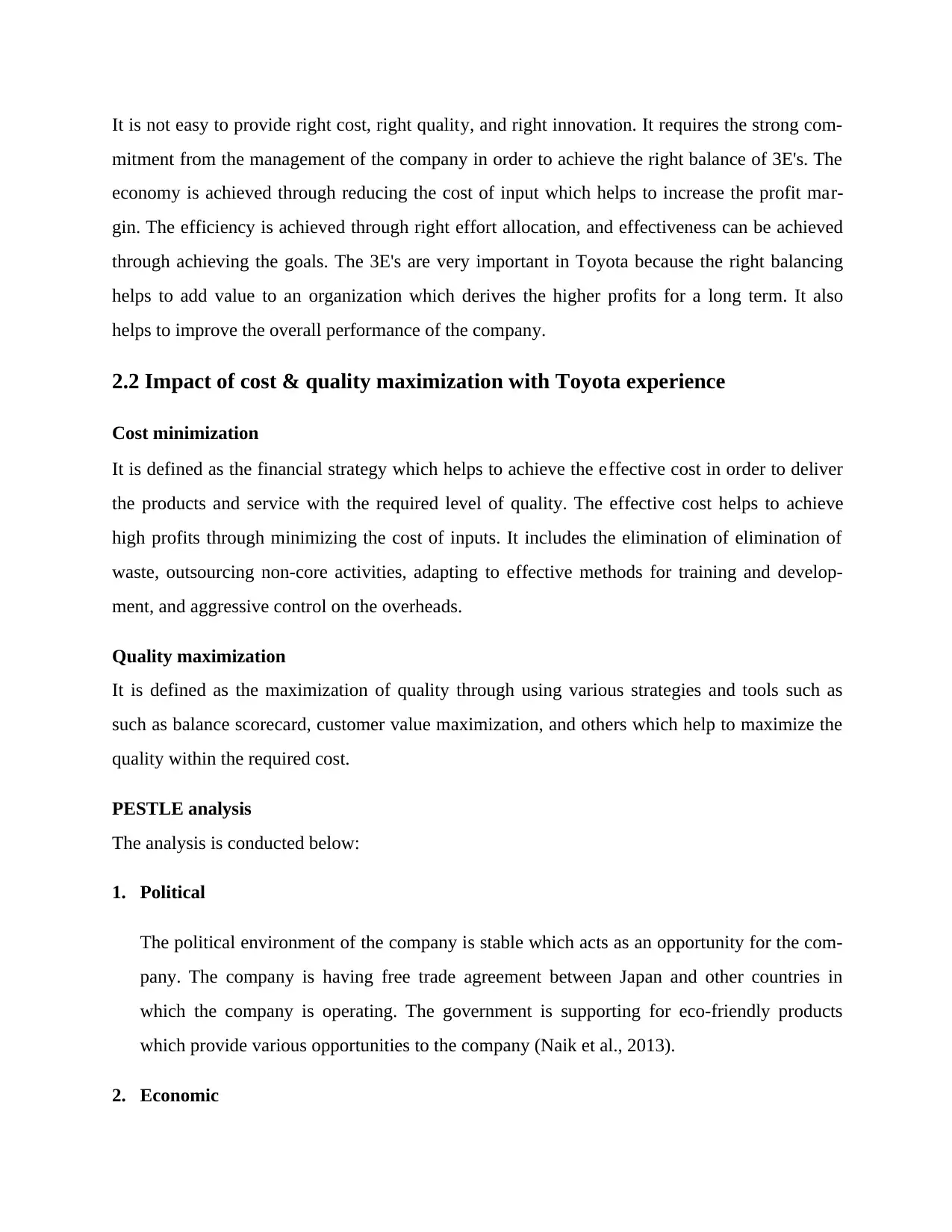
mitment from the management of the company in order to achieve the right balance of 3E's. The
economy is achieved through reducing the cost of input which helps to increase the profit mar-
gin. The efficiency is achieved through right effort allocation, and effectiveness can be achieved
through achieving the goals. The 3E's are very important in Toyota because the right balancing
helps to add value to an organization which derives the higher profits for a long term. It also
helps to improve the overall performance of the company.
2.2 Impact of cost & quality maximization with Toyota experience
Cost minimization
It is defined as the financial strategy which helps to achieve the effective cost in order to deliver
the products and service with the required level of quality. The effective cost helps to achieve
high profits through minimizing the cost of inputs. It includes the elimination of elimination of
waste, outsourcing non-core activities, adapting to effective methods for training and develop-
ment, and aggressive control on the overheads.
Quality maximization
It is defined as the maximization of quality through using various strategies and tools such as
such as balance scorecard, customer value maximization, and others which help to maximize the
quality within the required cost.
PESTLE analysis
The analysis is conducted below:
1. Political
The political environment of the company is stable which acts as an opportunity for the com-
pany. The company is having free trade agreement between Japan and other countries in
which the company is operating. The government is supporting for eco-friendly products
which provide various opportunities to the company (Naik et al., 2013).
2. Economic
Paraphrase This Document
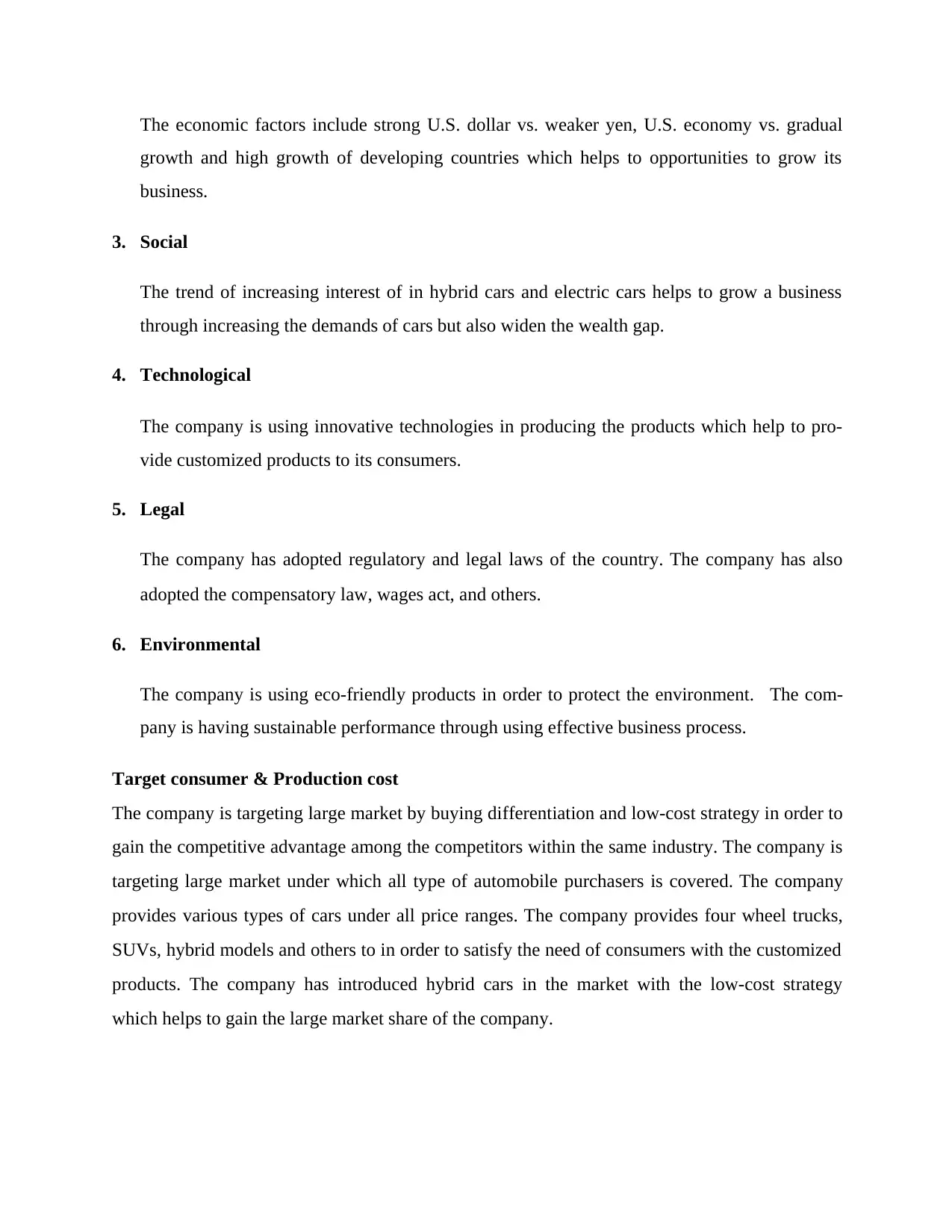
growth and high growth of developing countries which helps to opportunities to grow its
business.
3. Social
The trend of increasing interest of in hybrid cars and electric cars helps to grow a business
through increasing the demands of cars but also widen the wealth gap.
4. Technological
The company is using innovative technologies in producing the products which help to pro-
vide customized products to its consumers.
5. Legal
The company has adopted regulatory and legal laws of the country. The company has also
adopted the compensatory law, wages act, and others.
6. Environmental
The company is using eco-friendly products in order to protect the environment. The com-
pany is having sustainable performance through using effective business process.
Target consumer & Production cost
The company is targeting large market by buying differentiation and low-cost strategy in order to
gain the competitive advantage among the competitors within the same industry. The company is
targeting large market under which all type of automobile purchasers is covered. The company
provides various types of cars under all price ranges. The company provides four wheel trucks,
SUVs, hybrid models and others to in order to satisfy the need of consumers with the customized
products. The company has introduced hybrid cars in the market with the low-cost strategy
which helps to gain the large market share of the company.
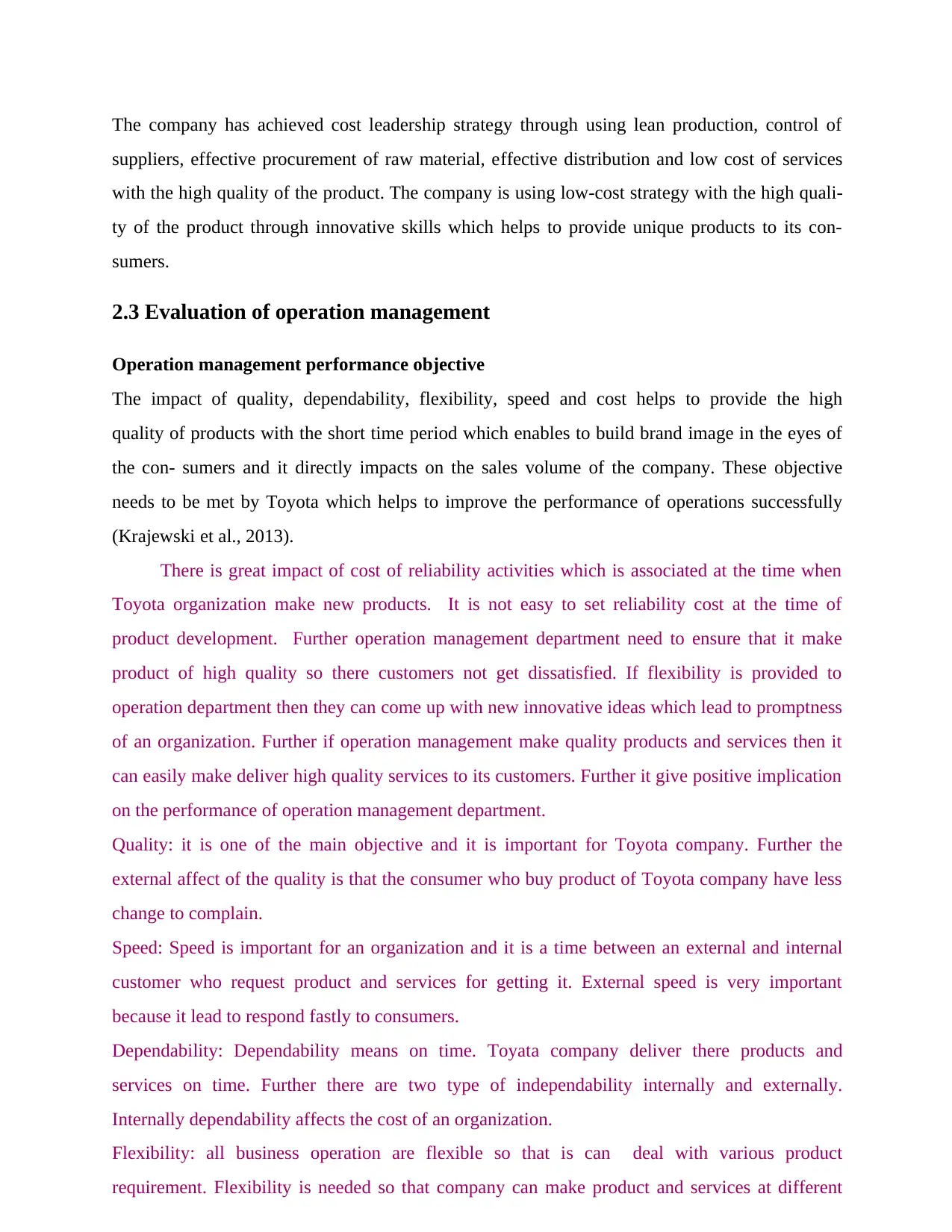
suppliers, effective procurement of raw material, effective distribution and low cost of services
with the high quality of the product. The company is using low-cost strategy with the high quali-
ty of the product through innovative skills which helps to provide unique products to its con-
sumers.
2.3 Evaluation of operation management
Operation management performance objective
The impact of quality, dependability, flexibility, speed and cost helps to provide the high
quality of products with the short time period which enables to build brand image in the eyes of
the con- sumers and it directly impacts on the sales volume of the company. These objective
needs to be met by Toyota which helps to improve the performance of operations successfully
(Krajewski et al., 2013).
There is great impact of cost of reliability activities which is associated at the time when
Toyota organization make new products. It is not easy to set reliability cost at the time of
product development. Further operation management department need to ensure that it make
product of high quality so there customers not get dissatisfied. If flexibility is provided to
operation department then they can come up with new innovative ideas which lead to promptness
of an organization. Further if operation management make quality products and services then it
can easily make deliver high quality services to its customers. Further it give positive implication
on the performance of operation management department.
Quality: it is one of the main objective and it is important for Toyota company. Further the
external affect of the quality is that the consumer who buy product of Toyota company have less
change to complain.
Speed: Speed is important for an organization and it is a time between an external and internal
customer who request product and services for getting it. External speed is very important
because it lead to respond fastly to consumers.
Dependability: Dependability means on time. Toyata company deliver there products and
services on time. Further there are two type of independability internally and externally.
Internally dependability affects the cost of an organization.
Flexibility: all business operation are flexible so that is can deal with various product
requirement. Flexibility is needed so that company can make product and services at different
⊘ This is a preview!⊘
Do you want full access?
Subscribe today to unlock all pages.

Trusted by 1+ million students worldwide
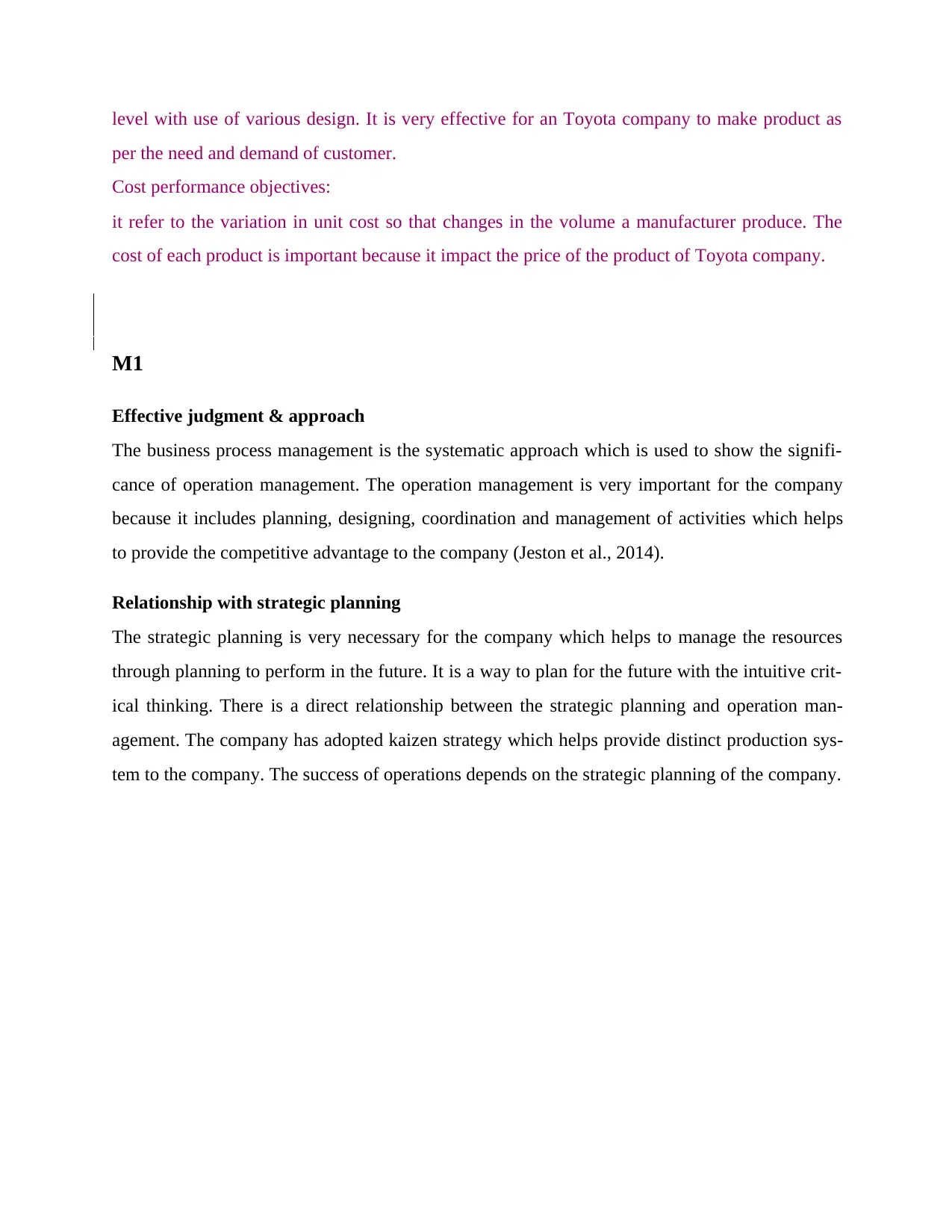
per the need and demand of customer.
Cost performance objectives:
it refer to the variation in unit cost so that changes in the volume a manufacturer produce. The
cost of each product is important because it impact the price of the product of Toyota company.
M1
Effective judgment & approach
The business process management is the systematic approach which is used to show the signifi-
cance of operation management. The operation management is very important for the company
because it includes planning, designing, coordination and management of activities which helps
to provide the competitive advantage to the company (Jeston et al., 2014).
Relationship with strategic planning
The strategic planning is very necessary for the company which helps to manage the resources
through planning to perform in the future. It is a way to plan for the future with the intuitive crit-
ical thinking. There is a direct relationship between the strategic planning and operation man-
agement. The company has adopted kaizen strategy which helps provide distinct production sys-
tem to the company. The success of operations depends on the strategic planning of the company.
Paraphrase This Document
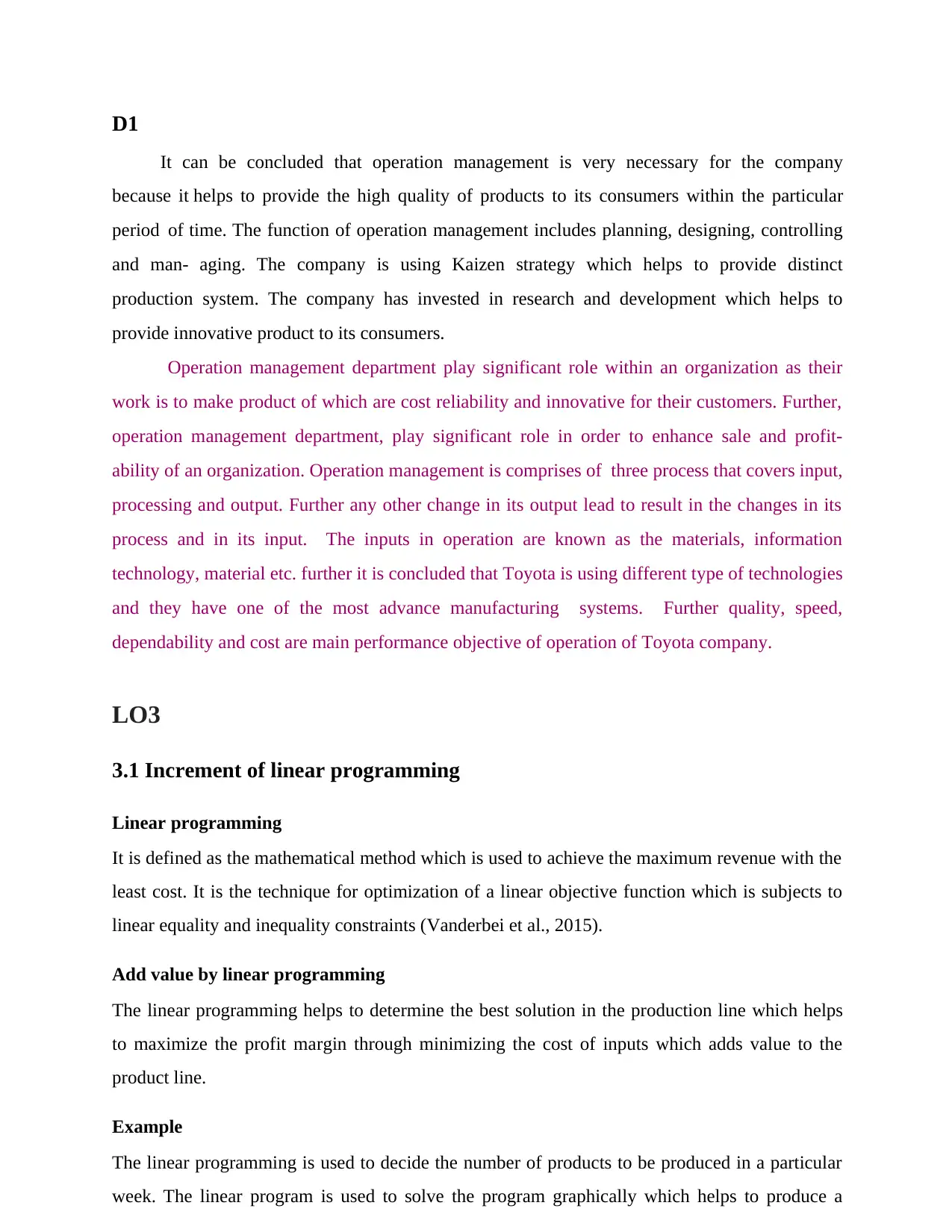
It can be concluded that operation management is very necessary for the company
because it helps to provide the high quality of products to its consumers within the particular
period of time. The function of operation management includes planning, designing, controlling
and man- aging. The company is using Kaizen strategy which helps to provide distinct
production system. The company has invested in research and development which helps to
provide innovative product to its consumers.
Operation management department play significant role within an organization as their
work is to make product of which are cost reliability and innovative for their customers. Further,
operation management department, play significant role in order to enhance sale and profit-
ability of an organization. Operation management is comprises of three process that covers input,
processing and output. Further any other change in its output lead to result in the changes in its
process and in its input. The inputs in operation are known as the materials, information
technology, material etc. further it is concluded that Toyota is using different type of technologies
and they have one of the most advance manufacturing systems. Further quality, speed,
dependability and cost are main performance objective of operation of Toyota company.
LO3
3.1 Increment of linear programming
Linear programming
It is defined as the mathematical method which is used to achieve the maximum revenue with the
least cost. It is the technique for optimization of a linear objective function which is subjects to
linear equality and inequality constraints (Vanderbei et al., 2015).
Add value by linear programming
The linear programming helps to determine the best solution in the production line which helps
to maximize the profit margin through minimizing the cost of inputs which adds value to the
product line.
Example
The linear programming is used to decide the number of products to be produced in a particular
week. The linear program is used to solve the program graphically which helps to produce a
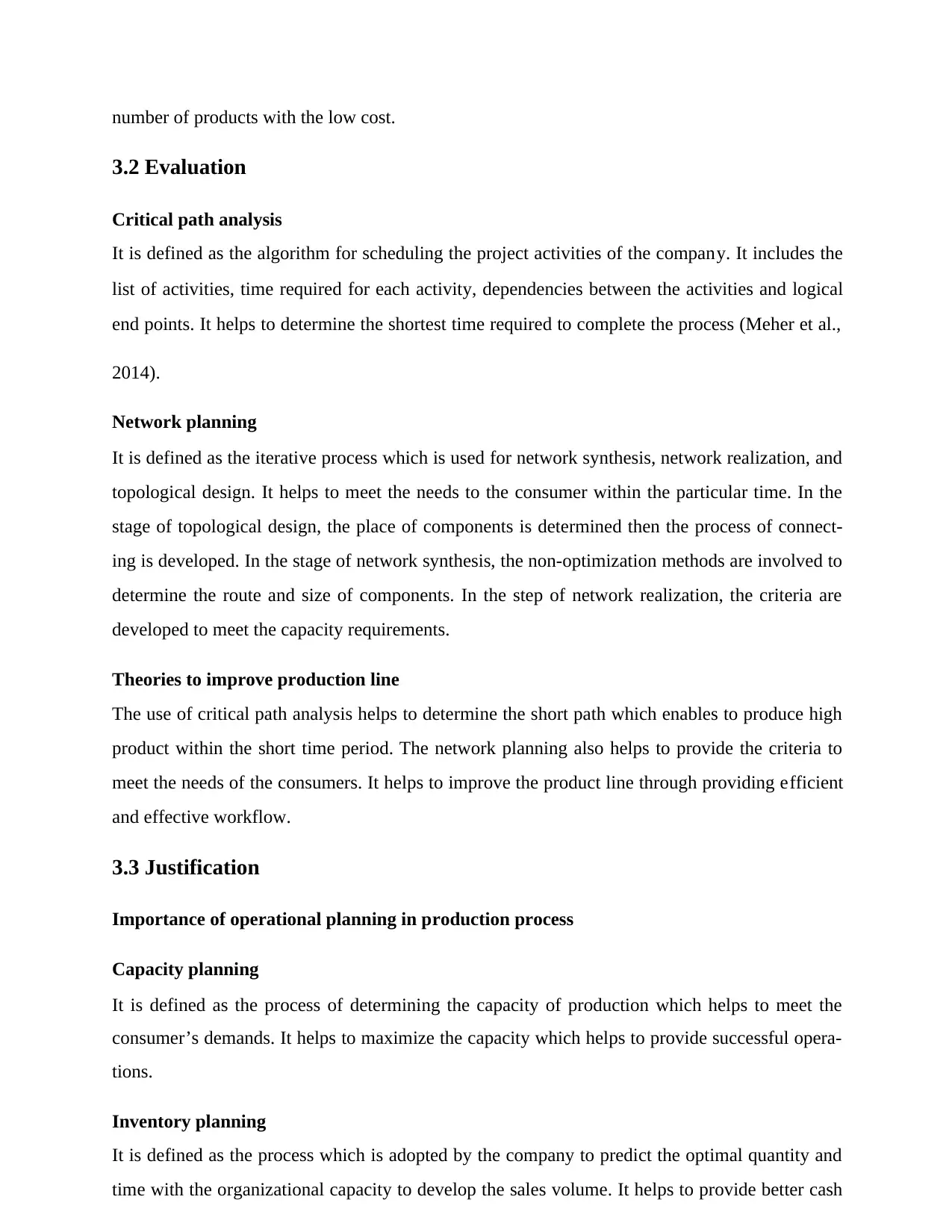
3.2 Evaluation
Critical path analysis
It is defined as the algorithm for scheduling the project activities of the company. It includes the
list of activities, time required for each activity, dependencies between the activities and logical
end points. It helps to determine the shortest time required to complete the process (Meher et al.,
2014).
Network planning
It is defined as the iterative process which is used for network synthesis, network realization, and
topological design. It helps to meet the needs to the consumer within the particular time. In the
stage of topological design, the place of components is determined then the process of connect-
ing is developed. In the stage of network synthesis, the non-optimization methods are involved to
determine the route and size of components. In the step of network realization, the criteria are
developed to meet the capacity requirements.
Theories to improve production line
The use of critical path analysis helps to determine the short path which enables to produce high
product within the short time period. The network planning also helps to provide the criteria to
meet the needs of the consumers. It helps to improve the product line through providing efficient
and effective workflow.
3.3 Justification
Importance of operational planning in production process
Capacity planning
It is defined as the process of determining the capacity of production which helps to meet the
consumer’s demands. It helps to maximize the capacity which helps to provide successful opera-
tions.
Inventory planning
It is defined as the process which is adopted by the company to predict the optimal quantity and
time with the organizational capacity to develop the sales volume. It helps to provide better cash
⊘ This is a preview!⊘
Do you want full access?
Subscribe today to unlock all pages.

Trusted by 1+ million students worldwide
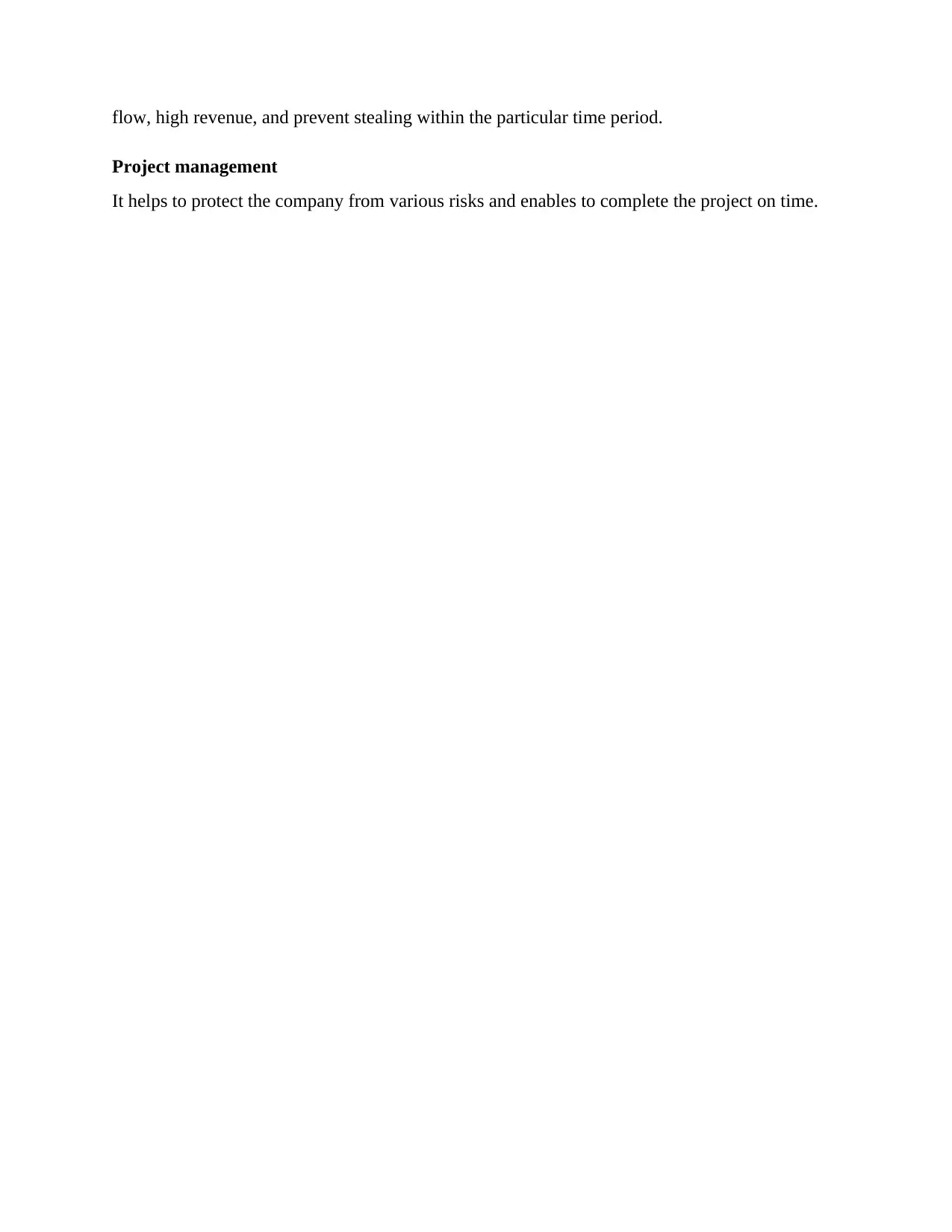
Project management
It helps to protect the company from various risks and enables to complete the project on time.
Paraphrase This Document
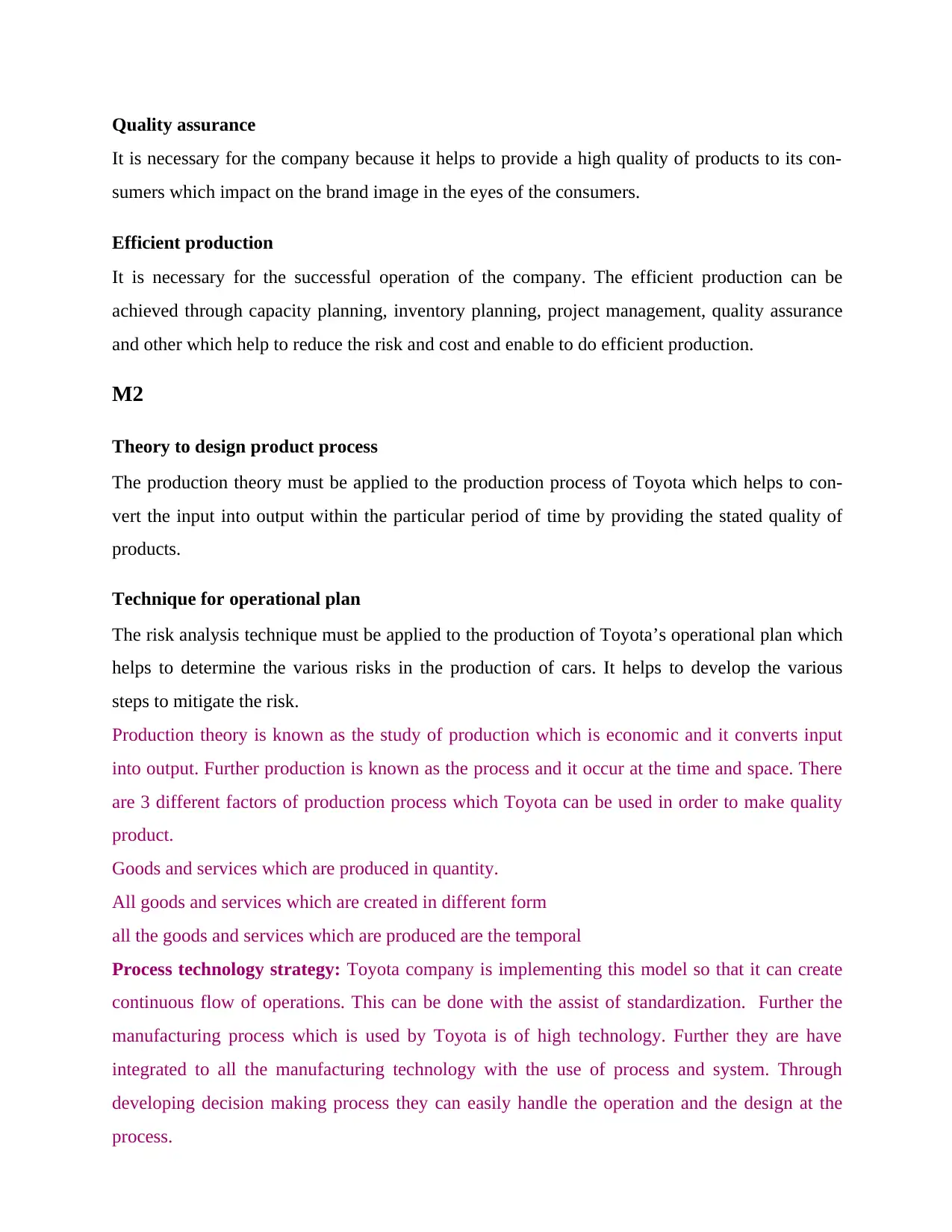
It is necessary for the company because it helps to provide a high quality of products to its con-
sumers which impact on the brand image in the eyes of the consumers.
Efficient production
It is necessary for the successful operation of the company. The efficient production can be
achieved through capacity planning, inventory planning, project management, quality assurance
and other which help to reduce the risk and cost and enable to do efficient production.
M2
Theory to design product process
The production theory must be applied to the production process of Toyota which helps to con-
vert the input into output within the particular period of time by providing the stated quality of
products.
Technique for operational plan
The risk analysis technique must be applied to the production of Toyota’s operational plan which
helps to determine the various risks in the production of cars. It helps to develop the various
steps to mitigate the risk.
Production theory is known as the study of production which is economic and it converts input
into output. Further production is known as the process and it occur at the time and space. There
are 3 different factors of production process which Toyota can be used in order to make quality
product.
Goods and services which are produced in quantity.
All goods and services which are created in different form
all the goods and services which are produced are the temporal
Process technology strategy: Toyota company is implementing this model so that it can create
continuous flow of operations. This can be done with the assist of standardization. Further the
manufacturing process which is used by Toyota is of high technology. Further they are have
integrated to all the manufacturing technology with the use of process and system. Through
developing decision making process they can easily handle the operation and the design at the
process.
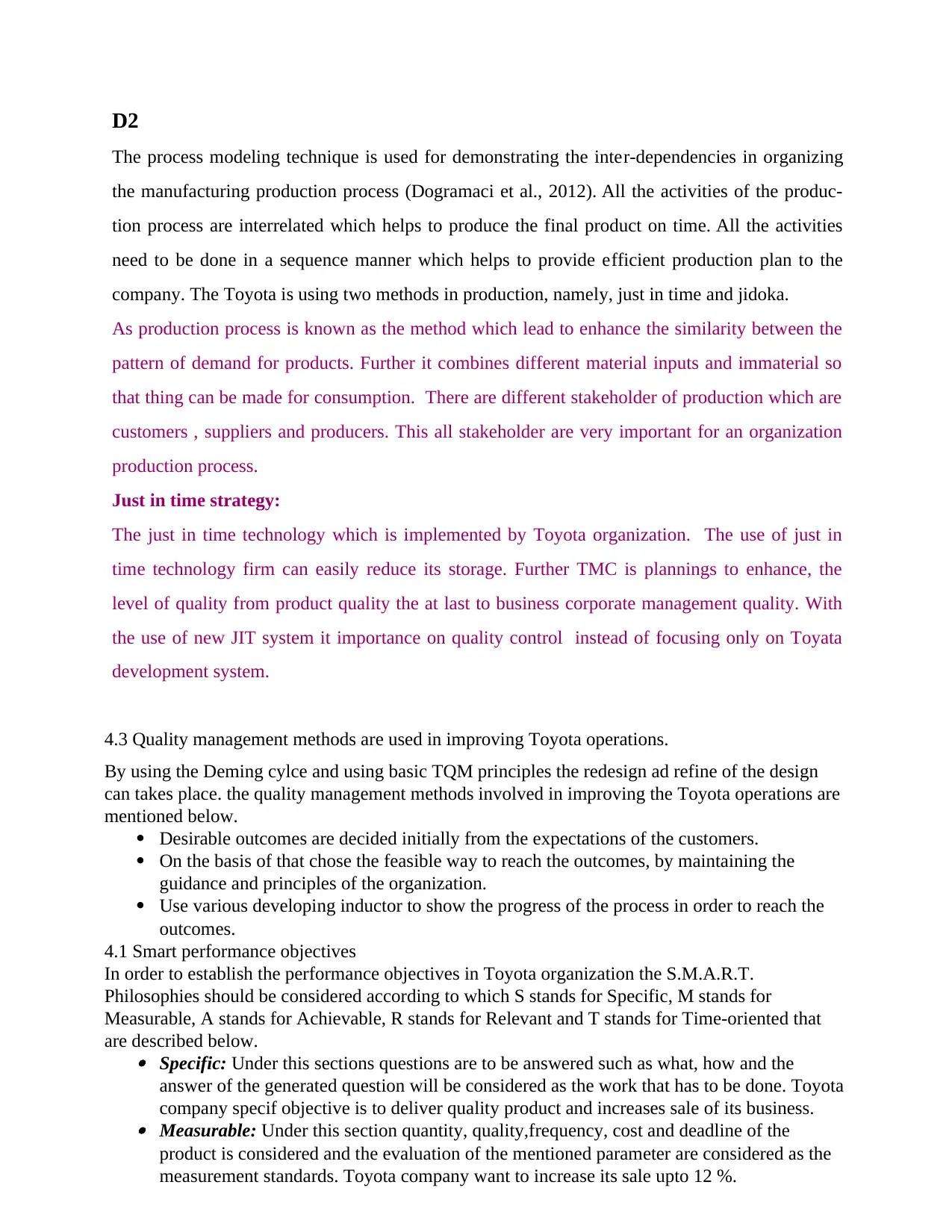
The process modeling technique is used for demonstrating the inter-dependencies in organizing
the manufacturing production process (Dogramaci et al., 2012). All the activities of the produc-
tion process are interrelated which helps to produce the final product on time. All the activities
need to be done in a sequence manner which helps to provide efficient production plan to the
company. The Toyota is using two methods in production, namely, just in time and jidoka.
As production process is known as the method which lead to enhance the similarity between the
pattern of demand for products. Further it combines different material inputs and immaterial so
that thing can be made for consumption. There are different stakeholder of production which are
customers , suppliers and producers. This all stakeholder are very important for an organization
production process.
Just in time strategy:
The just in time technology which is implemented by Toyota organization. The use of just in
time technology firm can easily reduce its storage. Further TMC is plannings to enhance, the
level of quality from product quality the at last to business corporate management quality. With
the use of new JIT system it importance on quality control instead of focusing only on Toyata
development system.
4.3 Quality management methods are used in improving Toyota operations.
By using the Deming cylce and using basic TQM principles the redesign ad refine of the design
can takes place. the quality management methods involved in improving the Toyota operations are
mentioned below.
Desirable outcomes are decided initially from the expectations of the customers.
On the basis of that chose the feasible way to reach the outcomes, by maintaining the
guidance and principles of the organization.
Use various developing inductor to show the progress of the process in order to reach the
outcomes.
4.1 Smart performance objectives
In order to establish the performance objectives in Toyota organization the S.M.A.R.T.
Philosophies should be considered according to which S stands for Specific, M stands for
Measurable, A stands for Achievable, R stands for Relevant and T stands for Time-oriented that
are described below.
Specific: Under this sections questions are to be answered such as what, how and the
answer of the generated question will be considered as the work that has to be done. Toyota
company specif objective is to deliver quality product and increases sale of its business.
Measurable: Under this section quantity, quality,frequency, cost and deadline of the
product is considered and the evaluation of the mentioned parameter are considered as the
measurement standards. Toyota company want to increase its sale upto 12 %.
⊘ This is a preview!⊘
Do you want full access?
Subscribe today to unlock all pages.

Trusted by 1+ million students worldwide

that can be done by the individuals. Only those tasks are considered as the achievable that
satisfies the measurable objective. Toyota company want to increase its sale upto 12 %
within a 9 month.
Relevant: Under this section only the relevant objective should be included that is a part of
the strategic plan. Relevant objectives of Toyota company is make product and services for
its customer of high quality.
Time-oriented: Under this section various end points and checkpoint are considered in
order to check the progress of the tack. Time period to achieve its objectives is 9 to 10
months
M 3
In order to maximize the sales of the Toyota organisations in next three month by using various
methodologies at various level of the process such as designing, developing, testing and marketing
level and much more. This various levels can be achieved by using developing models such as the
Deming cylce and using basic TQM principles that are used in the designing and the developing
stage of the process. While the performance of the product is measured on the philosophy of
SMART. Where each step is associated with the previous one and output of one is considered as
the input of the next stage.
D 3
In order to improve the development process of the Toyota organization the implementation of the
customer's expectations should be considered. Their feedback also included while the process of
redesigning of the product and testing of the product should be at every stage so that the quality of
the product remain maintained. Along with this involvement of new technologies should be
increased in order to attract the customer's and the safety of the product should be maintained and
any kind of compensation should not be considerable. On the basis of the above mentioned factors
new customer's will be attracted towards the organisations and the trust of the existing customer's
will be maitained.
Paraphrase This Document
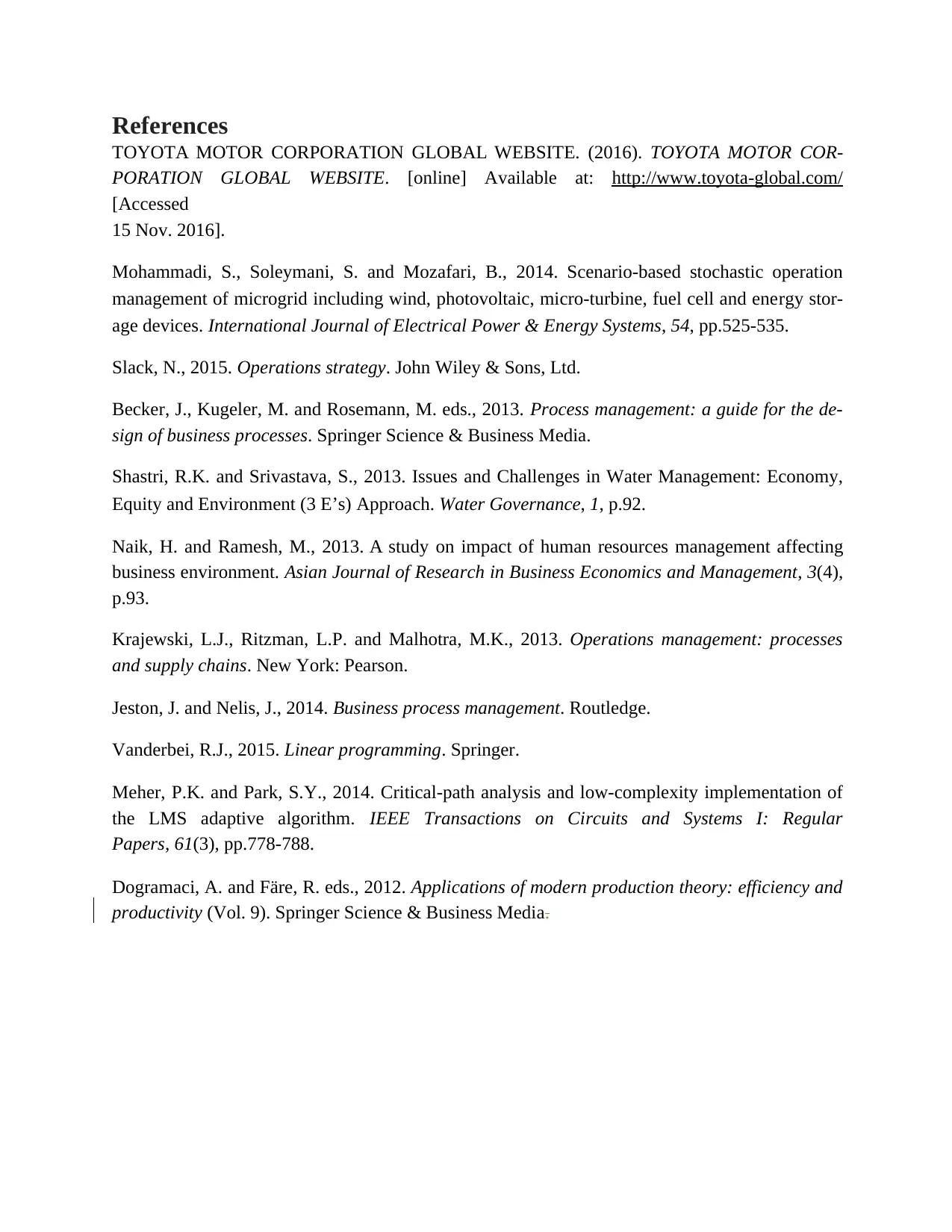
TOYOTA MOTOR CORPORATION GLOBAL WEBSITE. (2016). TOYOTA MOTOR COR-
PORATION GLOBAL WEBSITE. [online] Available at: http://www.toyota-global.com/
[Accessed
15 Nov. 2016].
Mohammadi, S., Soleymani, S. and Mozafari, B., 2014. Scenario-based stochastic operation
management of microgrid including wind, photovoltaic, micro-turbine, fuel cell and energy stor-
age devices. International Journal of Electrical Power & Energy Systems, 54, pp.525-535.
Slack, N., 2015. Operations strategy. John Wiley & Sons, Ltd.
Becker, J., Kugeler, M. and Rosemann, M. eds., 2013. Process management: a guide for the de-
sign of business processes. Springer Science & Business Media.
Shastri, R.K. and Srivastava, S., 2013. Issues and Challenges in Water Management: Economy,
Equity and Environment (3 E’s) Approach. Water Governance, 1, p.92.
Naik, H. and Ramesh, M., 2013. A study on impact of human resources management affecting
business environment. Asian Journal of Research in Business Economics and Management, 3(4),
p.93.
Krajewski, L.J., Ritzman, L.P. and Malhotra, M.K., 2013. Operations management: processes
and supply chains. New York: Pearson.
Jeston, J. and Nelis, J., 2014. Business process management. Routledge.
Vanderbei, R.J., 2015. Linear programming. Springer.
Meher, P.K. and Park, S.Y., 2014. Critical-path analysis and low-complexity implementation of
the LMS adaptive algorithm. IEEE Transactions on Circuits and Systems I: Regular
Papers, 61(3), pp.778-788.
Dogramaci, A. and Färe, R. eds., 2012. Applications of modern production theory: efficiency and
productivity (Vol. 9). Springer Science & Business Media.

⊘ This is a preview!⊘
Do you want full access?
Subscribe today to unlock all pages.

Trusted by 1+ million students worldwide
Related Documents
Your All-in-One AI-Powered Toolkit for Academic Success.
+13062052269
info@desklib.com
Available 24*7 on WhatsApp / Email
![[object Object]](/_next/static/media/star-bottom.7253800d.svg)
© 2024 | Zucol Services PVT LTD | All rights reserved.





